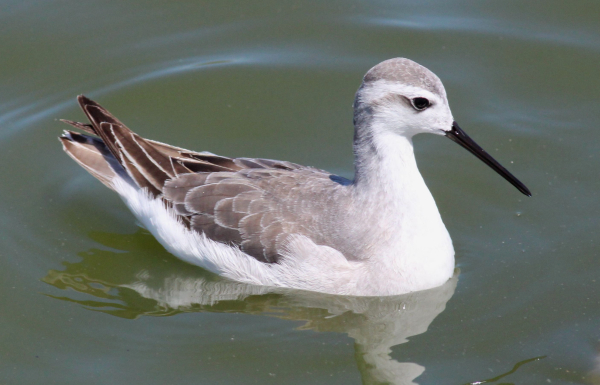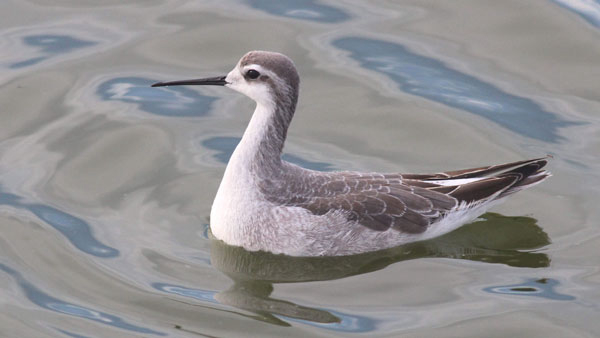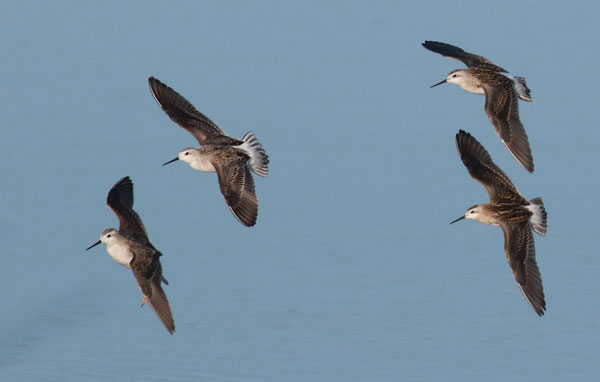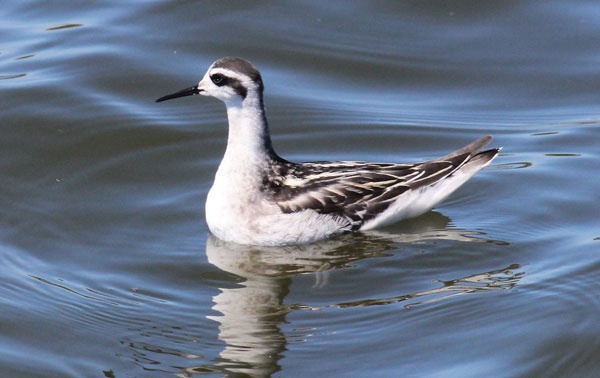The word “Basic” is the key word in the title because at this time of the year the colorful male and even more colorful female phalaropes have replaced their fine alternate (breeding) plumage for their basic plumage that will serve them until next spring. Even though this basic plumage is less colorful, it’s surprisingly attractive when you get a close look at “basic” phalaropes, especially when you can inspect individual feathers. That takes getting close to these small shorebirds, regardless of what kind of telephoto or zoom lens you are using. To get close, you need to approach some trusting phalaropes.

First, let’s identify what phalaropes you may have before you. There are three species of phalaropes found worldwide – Wilson’s, Red-necked, and Red Phalaropes – and North America hosts all three species. Wilson’s Phalaropes are only found in the Western Hemisphere; they nest and migrate through North America but spend most of the year in South American wetlands west and south of the Amazon River basin. Most often, Wilson’s Phalaropes will be the phalaropes we will encounter post-nesting.
While phalarope plumages are sexually different during the nesting season when the females are most colorful, in their basic plumage males and females are indistinct. The basic plumage of Wilson’s Phalaropes is colored gray and white, but a pleasing blend of gray and white. During the post-nesting period, Wilson’s will usually be found in small flocks, swimming in shallow water, plucking small crustaceans and insects from the just below the surface; and some may be seen wading along shorelines, very shallow wetland edges, or rainwater ponds. Phalaropes are also celebrated for their rather unique method of swimming in small circles to create a water vortex that captures small aquatic crustaceans and insect larvae and spins them up to the surface where the whirling phalaropes pick them from the water.

When you have located phalaropes at a stopover locale as they move from nesting areas and prepare for their long migration to wintering sites, all the basic aspects of photography kicks in – the direction of the light source, time of day, aperture and shutter speed, making a relatively close approach without disturbing the birds, following motion. These are photo variables we often address, so let’s consider a couple photo options focused on phalaropes. Undoubtedly, you will find phalaropes swimming in water, or wading in the shallows, which adds the element of photographing with the effects of reflected colors and motion of water.
Watery Settings
I enjoy photographing with water as a setting because it creates a lot of potential for adding some artistry created by the water setting. For the most part, we utilize the water conditions we get: The colors reflected from the sky or surroundings in a given photo session, or during a given moment. But by moving this way or that, we may be able to use calmer or different-colored water settings as we are dictated by the movements of the birds. Colors and color patterns will change dramatically with the motion of water, that may vary from slight ripples in mostly calm water, to small or larger wave action, all of which will change the water color and texture in photos moment to moment.

Action photos of more than one bird are tricky, but this photo of a small flock of Wilson’s Phalarope landing recorded the birds in synchrony, and their action was effectively stopped by using a fast shutter speed. These birds were photographed a month earlier than the first two, while they were in the final stage of molting into basic plumage.
|
After taking initial photos focused on the birds, you can start watching the water to try to photograph when a bird is between waves or moves to a calmer location. You can even look ahead of the bird to see if water action and color changes or improves as the bird advances. Realistically though, we are focused on the phalaropes, analyzing their every move and taking photos at what we perceive as the right moments. In the moment, try to anticipate the actions of these fast-moving birds, and take plenty of photos to ensure you get some that reflect the birds and their surroundings best.
Today’s elite digital cameras fitted with zoom or telephoto lenses permit us to take photos that show details of individual feathers, overall plumage, and varied markings. Sometimes, the degree of detail we get in our photos is better than what we can perceive with our eyes. When you get photos of that nature, consider it a personal accomplishment, and appreciate the intricacy and beauty of the birds’ structure, feathers, and plumage tracts.
Portraits of the birds are great, and often easiest to take, but try to take action photos when possible. You never know how action photos will turn out, but it’s always worth a try. When reviewing photos I took during photo sessions of phalaropes in basic plumages, I found that the action photos I took weren’t as pleasing as the portraits, so I emphasize portraits as illustrations for this article. That’s part of the editing process – which is part of any photo session – picking out the best photos.
Cropping Photos
Speaking of editing, once you have reviewed images from a photo session and selected your favorites, consider each one to see if treatment with your photo editing software would improve them. I’m not talking about major photo edits; for this article I merely cropped the images to emphasize the birds and limit the span of their surroundings. Cropping extraneous areas of photos is the best way to improve the photos you take, thereby emphasizing important elements, and eliminating unnecessary or distracting things as best you can.
One thing to keep in mind when cropping a bird photo is that you should make sure you’re working with a very sharp photo to begin with. Then be sure that when you apply your crop, the bird remains sharp in the image. As you crop extraneous background, you are enlarging the bird within the frame, and that can make a small sharp photo a bit fuzzy in the details when cropped.
Check the eye to measure the sharpness of the bird in the photo – the eyes will be the best indicator of the sharpness of the overall image. The setting can blur, as it often does due to a given aperture’s sometimes limited field of focus; but just as you should focus on the bird’s eye when taking photos, you can judge the sharpness of an image by checking the sharpness of the eyes.

What interesting shorebirds they are, these phalaropes. I hope you are lucky enough to encounter these interesting, attractive birds in their alternate “nesting” plumage in season, and in their basic plumage now. If you are really lucky, you may encounter a Red-necked Phalarope en route to their offshore wintering range. But an offshore birding trip may yield Red-necks on the open sea, where you may also find Red Phalaropes in basic plumage – what a thrill that would be!
Of course, all the information discussed in this article can be applied to other shorebirds, as well as waterbirds, wading birds, waterfowl, and seabirds that are found in aquatic habitats. I hope you have a chance to enjoy and hone your photo skills in a watery setting soon, maybe this week.
Article and photographs by Paul Konrad
Share your bird photos and birding experiences at editorstbw2@gmail.com